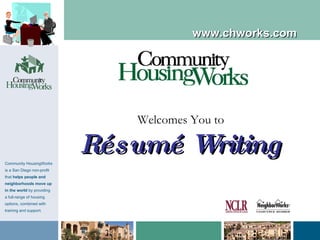RÃĐsumÃĐ Writing Presentation
- 1. Welcomes You to RÃĐsumÃĐ Writing www.chworks.com Community HousingWorks is a San Diego non-profit that helps people and neighborhoods move up in the world by providing a full-range of housing options, combined with training and support.
- 2. Be truthful - State your abilities accurately. Target your audience - Highlight skills and activities relevant to the job. Keep it brief - Limit your resume to one or two pages, and use fewer words for scannability. Write and rewrite - Plan to write several versions of your resume before it feels right. Be professional - Print your resume on high-grade paper using a quality printer. Be accurate - Proofread your resume (and have a friend do the same) for any errors. Follow up -  Call or send a letter to the employer to restate your interest in the position. Before you start, rememberâĶ
- 3. Here are some basic types of rÃĐsumÃĐs: Chronological Functional Combination Types of RÃĐsumÃĐs
- 4. Chronological RÃĐsumÃĐs Chronological resumes present information in a timeline approach. The most recent work or educational experience is listed first , followed by the next most recent. This is the most common type of resume. It illustrates how you have made progress towards your career objective through your employment history. This type of resume is best if you have demonstrated experience within your desired career field . It highlights the positions you have held and the companies for which you have worked.
- 5. Chronological RÃĐsumÃĐs Emphasizes work history â where you worked and when. Easy for employers to scan. Often used by job seekers with steady work experience in their desired career field.
- 7. Chronological RÃĐsumÃĐs Pros and Cons Pros: Many employers and recruiters expect and prefer this format Employers can easily scan chronological resumes Provides a straightforward history of your work experiences Cons: Can demonstrate a lack of work experience Will show any gaps in employment history Employers can guess your age if you include older experiences
- 8. Functional RÃĐsumÃĐs With a functional resume , you can showcase the work experience that is most important to your career objective. It highlights more relevant skills instead of position titles. Functional resumes are useful for : Those with very diverse experiences that don't add up to a clear-cut career path. College students with minimal experience and/or experience unrelated to their chosen career field . Career-changers who wish to enter a field very different from what all their previous experience points to. Those with gaps in their work history , such as homemakers who took time to raise and family and now wish to return to the workplace. Job-seekers whose predominate or most relevant experience has been unpaid, such as volunteer work or college activities (coursework, class projects, extracurricular organizations, and sports).
- 10. Pros: Provides a flexible approach De-emphasizes lack of experience in a field Minimizes possible age discrimination  Cons: Employers may expect the chronological format Functional RÃĐsumÃĐs Pros and Cons
- 11. Combination RÃĐsumÃĐs Combination resumes merge the chronological and functional styles. They present the knowledge, skills and abilities gained from work in a reverse-chronological order. This resume type highlights your skills and experiences. The combination type of resume is best if you: Wish to include volunteer or internship experience Have a varied employment history - Are changing careers
- 13. Pros: Provides employers with the expected chronological format Highlights your skills Cons: Can be repetitious if similar functions or skills are utilized in different positions May be longer than the chronological and functional formats Combination RÃĐsumÃĐs Pros and Cons
- 14. Style Reminders Complete sentences are not necessary. Market yourself with action verbs , careful use of white space, and emphasis on indentation. One-inch margins and a balance of content in the body make your resume more readable. Be consistent in all resume design, text, and punctuation decisions. Be professional!
- 15. Style Reminders Key points to remember: Use a readable font rather than one that is decorative. Maintain font sizes between 10 and 14. White is still considered the best choice of paper color. Avoid unnecessary graphics and shading. Use laser printing on high quality paper. Make sure photocopies of your resume are clean and sharp . Never handwrite your resume!
- 16. Items of Controversy - Avoid listing political affiliation, controversial employers or activities, or religious beliefs. Follow this rule unless you are applying for a political, activist, or religious job. Personal Information - Listing your age, height, weight, race, ethnicity, or marital status is not necessary . It may provide open invitations for discrimination. Personal References - Remove personal references from your resume. It is assumed you have references. Salary Requirements - Do not mention your salary desires or wage history. Errors - Check your resume several times for accuracy, consistency, correct use of grammar, and spelling. Stick with a single verb tense. Have someone proofread your resume. RÃĐsumÃĐ Donâts
- 17. Other Resources The information in this presentation can be found at http://www.careeronestop.org/ResumesInterviews For more help on writing a resume, visit these other great sites! http://www.jobstar.org/tools/resume/samples http://www.quintcareers.com/resume http://www.careerlab.com http://www.thebeehive.org
















